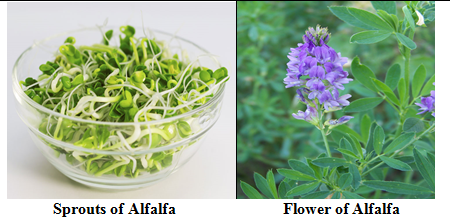Authors: R. Mahendran, J. Vanitha and J. Srinivasan
Introduction
Alfalfa also called as lucerne, is a perennial flowering crop belongs to the family Fabaceae, originated in southwestern Asia. Forage crops are grass and legume plant species that are grown for livestock feed as well as land conservation and reclamation. It is the most important "high quality" forage crop because of its high protein, vitamins, energy and digestibility. Alfalfa can be used whenever herbivores need high quality diet for growth, stamina, strength, production of meat, milk, wool, eggs, feathers, etc. Alfalfa is used as a high quality component of forage mixtures and allows use of lower quality forages in rations. It is also important for soil enrichment, soil water holding capacity improvement, mulch, and extraction of deep minerals and nitrogen. It is even used by humans for nutritional tablets and alfalfa sprouts. Because of its importance among forage crops, alfalfa is referred to as "Queen of Forages".
Cultivation methods
Lucerne has a deep root system consisting of strong main top root and number of lateral roots that makes the plant drought tolerant. It can be raised both as rainfed or irrigated crop in high water table areas. Lucerne is relished by all kinds of livestock, because it yields nutritious and palatable green fodder, which possesses about 16-25% crude protein and 20-30% fibre. Owing to its high protein and vitamin A content, it is included as a feed component in poultry and piggery. It can also be easily converted into silage and hay. Lucerne supplies green fodder for a longer period (November-June) in comparison to berseem (December-April). The flowers are usually purple, but it may be blue, yellow or white. They are fertilized by insects, especially bees.

Cropping Systems
It is usually raised after harvest of kharif crops, such as sorghum, paddy, soybean, maize, cowpea, clusterbean etc. It can be raised in rotation with almost every grain or forage crop. The most common crop rotations adopted in north India are namely: Maize, Paddy, Sorghum, Greengram, Soyabean, Cowpea + maize (fodder), Sorghum (grain), maize (fodder). It is intercropped with napier grass. Sometimes it is raised mixed with berseem to get the continuous supply of green fodder till May-June, where berseem is completely finished in hot months of April and May.
Soil and its preparation
Lucerne can be raised on a wide range of soils. However, well drained fertile soils with
neutral pH are ideal. Field should be prepared thoroughly and levelled properly. All the weeds and stubbles should be removed from the field before sowing. Plough the field once with mould board plough and 3-4 times with country plough, followed by planking each time to secure a firm and fine seedbed. A fine seedbed ensures better contact of seeds with soil particles and facilitates quick and better germination. In case of broadcast method, a seed rate of 20-25 kg/ha should be used. In this method, care should be taken to cover the seed with 1-2 cm layer of soil. After broadcast, mixing could be done either with rake or spike tooth harrow with zero cut. Seed may be broadcast after last harrowing and then covered with planking. Care should be taken that seed should not go more than one cm deep as seed size of lucerne is very small.
Yield
The first cut should be taken 50-55 days after sowing and the subsequent cuts at an interval of 25-35 days when crop attains the height of 60 cm from the surface of the soil. In a year, 7-8 cuts can be taken between October-April. The average green fodder yield of Lucerne varies from 80-120 t/ha.
The benefits of alfalfa to humans
For centuries, alfalfa has been used for medicinal purposes. Its many wondrous beneficial properties are not really a secret. In ancient China, alfalfa was used to treat conditions, such as kidney stones, gastrointestinal problems, etc. In Ayurveda, the ancient Indian medicinal practice, it is known to be an effective medicine for people who suffer from arthritis as well as digestive and gastro-intestinal diseases. Alfalfa chlorophyll is a powerful substance that is well-known for its healing properties, especially for skin problems. It is also used for high cholesterol, asthma, osteoarthritis, cancer, rheumatoid arthritis, diabetes, upset stomach, and a bleeding disorder called thrombocytopenic purpura. People also take alfalfa as a source of vitamins A, C, E, and K4; and minerals calcium, potassium, phosphorous, and iron.

Alfalfa has diuretic properties, which prevents disorders of the kidney like water retention. It also has great properties that prevent from developing Urinary Tract Infection [UTI]. The minerals found in this plant are also effective in countering menopausal symptoms. The detoxifying nature of alfalfa tea enables it to keep the sugar levels under control. Plus, being enriched with protein and fiber in abundance, it makes a wonderful snack for those who are on a weight loss regimen. A cup of alfalfa tea can help you beat stress and keep anxieties away. It is also known to be quite effective in solving insomnia and other sleep disorders.
References
1. Dan, U and D. Cosgrove. 2011. Alfalfa Management Guide. American Society of Agronomy. pp 10-16.
2. Rashmi, R. Manisha, S and Vikramaditya. 1997. Cultivation of alfalfa. Ancient Science of Life. 17(2): 117 â€" 119.
3. *beefandlamb.ahdb.org.uk.
About Author / Additional Info:
Currently I am working as assistant professor at sethu bhaskara agricultural college and research foundation, Karaikudi.